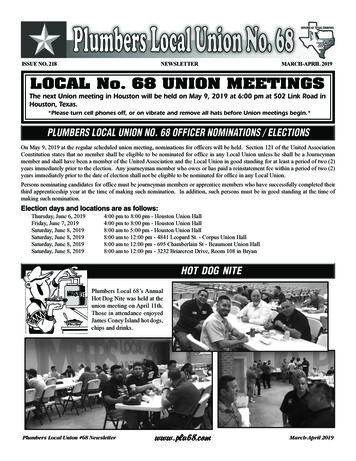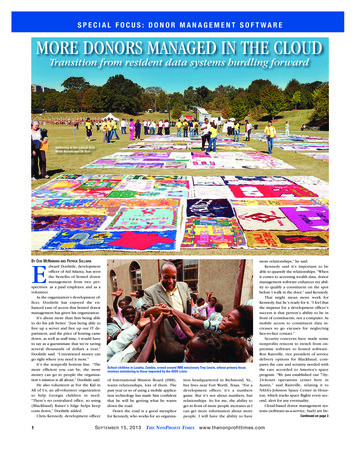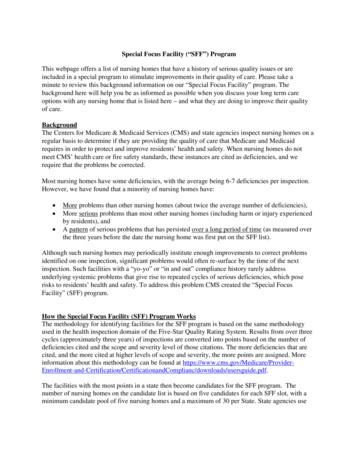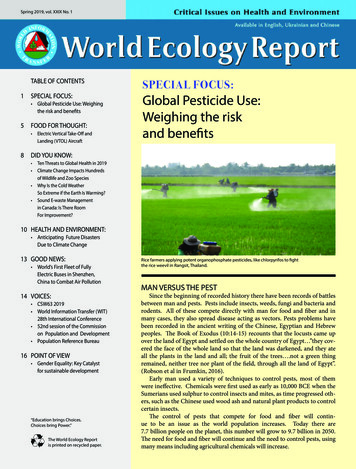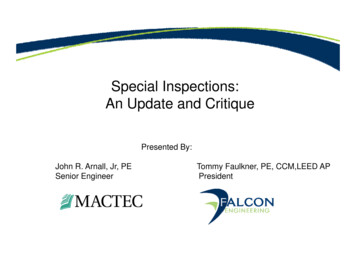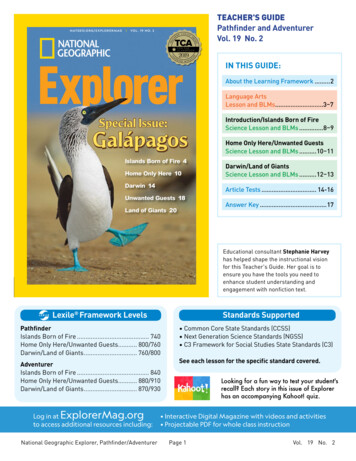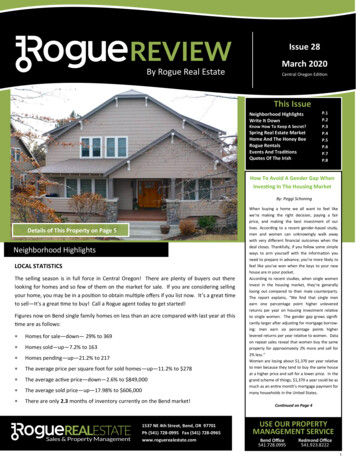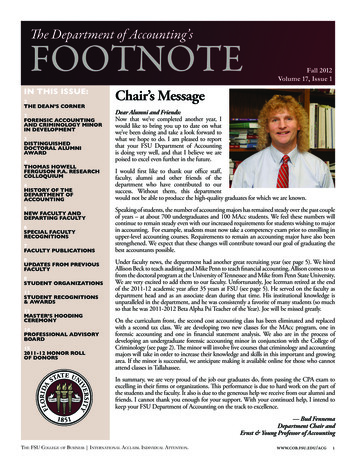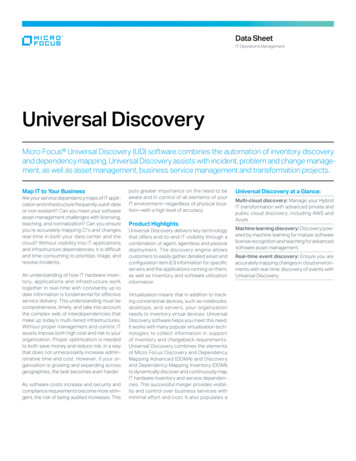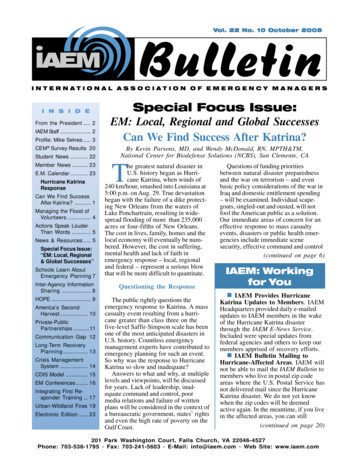
Transcription
Vol. 22 No. 10 October 2005From the President . 2IAEM Staff . 2Profile: Mike Selves . 3CEM Survey Results 20Student News . 22Member News . 23E.M. Calendar . 23Hurricane KatrinaResponseCan We Find SuccessAfter Katrina? . 1Managing the Flood ofVolunteers . 4Actions Speak LouderThan Words . 5News & Resources . 5Special Focus Issue:“EM: Local, Regional& Global Successes”Schools Learn AboutEmergency Planning 7Special Focus Issue:EM: Local, Regional and Global SuccessesCan We Find Success After Katrina?By Kevin Parsons, MD, and Wendy McDonald, RN, MPTH&TM,National Center for Biodefense Solutions (NCBS), San Clemente, CAThe greatest natural disaster inU.S. history began as Hurricane Katrina, when winds of240 km/hour, smashed into Louisiana at5:00 p.m. on Aug. 29. True devastationbegan with the failure of a dike protecting New Orleans from the waters ofLake Ponchartrain, resulting in widespread flooding of more than 235,000acres or four-fifths of New Orleans.The cost in lives, family, homes and thelocal economy will eventually be numbered. However, the cost in suffering,mental health and lack of faith inemergency response – local, regionaland federal – represent a serious blowthat will be more difficult to quantitate.Inter-Agency InformationSharing . 8Questioning the ResponseHOPE . 9The public rightly questions theemergency response to Katrina. A masscasualty event resulting from a hurricane greater than class three on thefive-level Saffir-Simpson scale has beenone of the most anticipated disasters inU.S. history. Countless emergencymanagement experts have contributed toemergency planning for such an event.So why was the response to HurricaneKatrina so slow and inadequate?Answers to what and why, at multiplelevels and viewpoints, will be discussedfor years. Lack of leadership, inadequate command and control, poormedia relations and failure of writtenplans will be considered in the context ofa bureaucratic government, states’ rightsand even the high rate of poverty on theGulf Coast.America’s SecondHarvest . 10Private-PublicPartnerships . 11Communication Gap 12Long-Term RecoveryPlanning . 13Crisis ManagementSystem . 14CDIS Model . 15EM Conferences . 16Integrating First Responder Training . 17Urban-Wildland Fires 19Electronic Edition . 23Questions of funding prioritiesbetween natural disaster preparednessand the war on terrorism – and evenbasic policy considerations of the war inIraq and domestic entitlement spending– will be examined. Individual scapegoats, singled-out and ousted, will notfool the American public as a solution.Our immediate areas of concern for aneffective response to mass casualtyevents, disasters or public health emergencies include immediate scenesecurity, effective command and control(continued on page 6)IAEM: Workingfor You IAEM Provides HurricaneKatrina Updates to Members. IAEMHeadquarters provided daily e-mailedupdates to IAEM members in the wakeof the Hurricane Katrina disasterthrough the IAEM E-News Service.Included were special updates fromfederal agencies and others to keep ourmembers apprised of recovery efforts. IAEM Bulletin Mailing toHurricane-Affected Areas. IAEM willnot be able to mail the IAEM Bulletin tomembers who live in postal zip codeareas where the U.S. Postal Service hasnot delivered mail since the HurricaneKatrina disaster. We do not yet knowwhen the zip codes will be deemedactive again. In the meantime, if you livein the affected areas, you can still(continued on page 20)201 Park Washington Court, Falls Church, VA 22046-4527Phone: 703-538-1795 Fax: 703-241-5603 E-Mail: info@iaem.com Web Site: www.iaem.com
October 2005IAEM BulletinFrom the PresidentHurricane Katrina: A Wake-Up CallBy Dewayne West, CEM, CFI, IAEM PresidentDirector, Johnston County Emergency Services, Smithfield, North CarolinaAs I write this article forthe October edition of theIAEM Bulletin, my heartis heavy watching the events andaftermath of Hurricane Katrina. Iknow you all share my concerns.We are in the midst of respondingto and recovering from the largestnatural catastrophe to strike theUnited States in our lifetime. Ourprayers go out to the victims andour counterparts in the affectedareas. Recovery will be long anddifficult.The events that continue tounfold underscore the critical needfor strong emergency managementprograms throughout the world.Any doubt regarding the value ofthe “all-hazards” approach to whatwe do or should be doing, hassurely been erased. Historically,adequate funding and staffing hasnot been provided to the extentneeded to address the variousphases of emergency preparedness. Added to this have beenguidelines and restrictions thathamper or prevent real preparedness and mitigation. This has tochange if we are to prevent similaroccurrences in the future.As our populations increase andhazards become more complex andchallenging, it is crucial thatofficials recognize the need andtheir responsibility for adequatefunding and support at all levels ofgovernment. No longer can wehave the “spare tire” syndromeapplied to emergency managementand expect it to perform flawlesslywhen disasters occur.Without question, there will bemuch finger-pointing by self-madeexperts and Monday morningquarterbacking in days to come.Unfortunately, it has already2started. However, I believe it is ourresponsibility as emergencymanagement professionals to stayfocused and unified in our approach and efforts to highlight theneeds and value of our profession.This includes public education,training, professional standards,code enforcement, public policy,funding, mitigation and legislation.The message is nothing new.Our efforts must continue toinclude individuals, families andcommunities. Public educationprograms must be expanded andenhanced, and citizens must beeducated regarding their role andresponsibility when confrontedwith a potential disaster. Theymust be trained in self-help procedures to look after themselves andtheir neighbors. Then governmentcan concentrate its resources onthose citizens and areas notcapable of self-help.We are also responsible forensuring that we as emergencymanagement professionals aretrained and prepared to do ourjobs. This includes training andeducation, professional development and program standards. Ifyou are not consistently upgradingyour knowledge base and capabilities, if you are not proactive inyour role and program development, then you need to consideranother vocation. Apathy is nolonger acceptable regardless of thesource. Our role and responsibilityis much too serious to be takenlightly.There must be a renewed effortat all levels to accomplish thesegoals. If this event doesn’t serveas a wake-up call to everyone,then I don’t know what it will take.The word must go forth fromIAEM members, our partnerorganizations, and anyone else whocan lend support, to convinceofficials and policy makers thatchange must come.After all, is that not what wehave been saying for some timenow? I hope you will join me inthis effort – our citizens deserveno less.Contact Your IAEM StaffExecutive DirectorElizabeth B. Armstrong, CAEPhone: 703-538-1795, ext. 6E-Mail: armstrong@iaem.comStaff ExecutiveClay D. Tyeryar, MAM, CAEPhone: 703-538-1795, ext. 5E-Mail: ctyeryar@asmii.netMembership Director/RegistrarSharon KellyPhone: 703-538-1795, ext. 2E-Mail: info@iaem.comCommunications/Marketing DirectorDawn Shiley-DanzeisenPhone: 703-538-1795, ext. 3E-Mail: shiley@iaem.comIAEM Bulletin EditorKaren ThompsonPhone: 703-644-2266E-Mail: thompson@iaem.comEMEX Exhibit ManagerLaurence Gration, CAEPhone: 703-538-1795, ext. 4E-Mail: LGration@emex.orgIAEM Policy AdvisorMartha BraddockPhone: 703-644-8557E-Mail: braddock@iaem.comIAEM Headquarters201 Park Washington CourtFalls Church, VA 22046-4527Phone: 703-538-1795Fax: 703-241-5603E-Mail: info@iaem.comWeb Site: www.iaem.com
October 2005IAEM BulletinProfile on Mike Selves, CEM, CPMCandidate for IAEM President-ElectMichael D. Selves, CEM,CPM, announced hiscandidacy for IAEMPresident-Elect in March 2005. Anannouncement of his candidacyappeared in the April 2005 IAEMBulletin.local homeland security funding,which produced a report that hashad a major impact on the efficiency and effectiveness of thehomeland security funding process.About Mike SelvesHere’s what Mike Selves saysabout why he is running for IAEMPresident-Elect:“I didn’t start 2005 convinced Iwas going to run for office.However, I began to seriouslyconsider running when, shortlyafter the IAEM Mid-Year Meeting,I had occasion to stay over for aweek and do one of IAEM PolicyAdvisor Martha Braddock’sCongressional visit ‘marathons.’As I moved from meeting tomeeting, I became more impressedwith the impact IAEM was makingand the magnitude of the changesand challenges we were facing. Ibegan to feel that our associationand our profession was at a criticalpoint – and that the next two tothree years would require strongleadership and articulate advocacy.“This last round of Congressional visits found us accepted andrespected, our input and advicevalued. Our partners, generallylarger and more influential, havebegun to accept us as equals. Withthis sense of achievement, however, comes the recognition thatthe principles and concepts wehave fought so hard to promote arenow, more than ever, at risk andstill not fully established. At thistime, we need to press the principles of our profession andarticulate the value of the comprehensive emergency managementapproach.“I have come to the realizationSelves has been an activemember of IAEM since 1995,serving as co-chairman of theIAEM Government AffairsCommittee since 2001 and asIAEM’s representative to theNACo Board of Directors for twoyears (2002-2004). He also chairsthe NACo Subcommittee onEmergency Management. Selves isDirector for Emergency Management & Homeland Security forJohnson County, Kansas. Previously, he was the EmergencyOperations Coordinator of LocalPrograms for the Kansas Divisionof Emergency Management inTopeka, where he establishedstandards for improving emergencypreparedness in all 105 Kansascounties.Selves served 20 years in theU.S. Air Force as a communications and war plans officer, retiringin 1987. He received his BSEddegree from Emporia StateUniversity, an MS degree inmanagement from the Universityof Arkansas, and has completed allcourse work toward a doctorate inhigher education and business atDenver University. He is currentlya course developer and instructorfor Park University’s master’sprogram in disaster emergencymanagement. In 2005, Selvesserved on a DHS-sponsored 20person task force on state andWhy Selves Is RunningMichael D. Selves, CEM, CPMthat those of us who have beenactively involved in IAEM owe itto our colleagues to promote anddefend their programs at home, aswell as to our young, energetic andeducated successors in college we owe them our passion, oureffort and our voices. It’s kind oflike the senior on the collegebasketball team who just made itinto the ‘big game.’ If we wereway ahead or way behind, youcould just ‘coast’ until it’s over andlet the younger players get someexperience. But if the season is inthe balance and the outcome iscritical, the first string has to beplayed.“In short, I am passionate aboutwhat we do as a profession, and Ifeel it’s valuable to our communities, the nation and the world. Ibelieve I have the knowledge,experience and leadership qualitiesto be the next President-Elect ofIAEM.”Contact Information:Michael D. Selves, CEM, CPMDirector, Emergency Management &Homeland Security, Johnson County111 S. Cherry, Suite 100Olathe, KS 66061Phone: 913-782-3038Fax: 913-791-5002E-Mail: mselves@jocogov.orgWeb Site: www.mikeselves.comIAEM 2005 Annual Conference & EMEX Exhibit“EM: Local, Regional and Global Successes”Nov. 11-16, 2005 Phoenix, ArizonaRegister at www.iaem.com3
October 2005IAEM BulletinHurricane Katrina ResponseManaging the Flood of VolunteersBy Kathleen G. Henning, MA, CEM, President, KGHenning & Associates,IAEM Representative to NVOAD Volunteer Management Committeeven as the floodwaters ofemphasis was on the managementwhich identifies strategies forHurricane Katrina wereof unsolicited donated goods andutilizing volunteers in all phases ofreceding in New Orleans,coordination among nationalemergency management: mitigaBiloxi and other communities in theaffiliated volunteer organizations.tion, preparedness, response, andhurricane- ravaged Southeast, aIn 2004, there were extensiverecovery. The document includesnew flood tide emerged – theefforts among various partnerlanguage for state and localflood of well-intentioned butagencies to extend the tools andemergency plans to incorporateunprepared unaffiliated volunteers.management principles for useunder volunteer management.Hurricane Katrina, Sept. 11, thewith unaffiliated volunteers.For a copy of the entire planningfour Florida hurricanes of 2004, thedocument, visit the Points of LightMidwest tornadoes and variousPartnersWeb site at www.pointsoflight.org/other disasters over the past yearsdownloads/pdf/programs/disaster/share a common element: theThe Points of Light Foundation,brochure.pdf.emergence of a large number ofwith funding from the UPS FounTo view examples of state plansunaffiliated volunteers respondingdation, has brought togetherthat include unaffiliated volunteerto the disaster sites. The challengepartners to address issues aroundmanagement, visit the NEMA Webhas been to tap into the energy andunaffiliated volunteers. Thesesite at www.nemaweb.org/compassion of volunteerismpartners include NVOAD, thedonations management/index.html.without burdening the alreadyAssociation for Volunteer Adminisovertaxed response system.tration (AVA), Volunteer Florida,Best Practices and TrainingCollaboration among variousAmericorps State Program,federal, state, local and nongovernDepartment of Homeland SecurityThe Disaster Volunteer Manmental partners has moved forRecovery Division, Humaneagement Committee began theward the efforts to put in place aSociety of the United States,process of compiling effectivenational strategy for the manageMissouri State Emergency Manpractices and models. At thement of unaffiliated volunteers.agement Agency (representingNVOAD national conference inMuch has already been done, butNEMA), IAEM, FEMA, AmericanJune, a training session wasmore clearly needs to done.Red Cross, Office of Citizenconducted for several pilot commuCorps, Corporation for Nationalnities. These communities wereEarly Effortsand Community Service, Salvationselected based on a diversity ofArmy, North Carolina Commissionregions, size of community, governAfter Hurricane Andrew inon Volunteerism and Communitymental and private affiliations, and1993, the Federal EmergencyService, National Organization forvarying levels of experience inManagement Agency broughtVictim Assistance, and Points ofdealing with volunteer managementtogether partner agencies to beginLight Foundation.programs. During the course of thethe work of developing a nationalnext year, a consultant has beenstrategy on the management ofSynergy of Structurehired to follow through with theseunsolicited donated goods andAnd Good Intentionscommunities and highlight bestunaffiliated volunteers in disaster.practices. The committee willFrom that auspicious beginningThe challenge presented to thecontinue to work at a national levelcame a 10-point National Donagroup was to help develop ato promote more effective mantions Management Strategy.structure for integrating emergentagement of volunteers.Voluntary disaster organizationsvolunteers and provide writtenOne of the principles promotedworked with state and localguidance to state and local organiby the Concept of Operations isofficials to develop donationszations. In 2004, a collaborativethat of “shared responsibility.”training programs and workshops,effort produced a working docuThe guidance notes that “thePSAs to promote 800 numbers,ment called “Managing Spontanemobilization, management andand an information managementous Volunteers in Times of Disassupport of volunteers is primarily asystem. (IAEM Bulletin, “Time forter: The Synergy of Structure andresponsibility of local governmentNational Strategy on UnaffiliatedGood Intentions.” The documentand nonprofit sector agencies, withVolunteers,” May 2003). The initialpresents a Concept of Operations(continued on page 6)E4
October 2005IAEM BulletinHurricane Katrina ResponseActions Speak Louder Than WordsBy Capt. Dinah Jeffries, ENP, Orange County Emergency Management, Hillsborough, North CarolinaIwill begin by saying that nodoubt we are all proud ofevery single individual,emergency service personnel,citizen, and any organizationassisting with this disaster. This isa time of crisis, in which those ofus who were not “physically” or“geographically” affected need toremember that it is not about us.We act without expectation, andwe succeed without taking credit.With that said, I implore us all tomonitor our e-mails and conversations and remember that others arereading them also. Updates aregreatly appreciated, but we mustremain sensitive to our personalremarks and “light” moments inrespect to the travails that many ofthe public safety agencies arefacing in the states affected.The most important issue here isthe strength and adversity that thepeople of the affected states havesuffered and will suffer for yearsto come. The really “tough” peopleare the ones who lived through theactualities of what happened. Weare not the “tough” ones.we arethe supporters. We, along withmultitudes of other states, aregiving what we “should” give –and that is our professionalism,our compassion and our dedicationto help rebuild shattered lives anddiminished hopes. The “praise” (orat least, my praise) goes out tothose emergency service professionals who have endured since thebeginning of this disaster. My“thanks” goes out to all of those,and our own – state and local –who are showing why we are inthis profession.We do not do this for therecognition of an individual organization. Hopefully, we do thisbecause it is our “duty” to help outour fellow brothers, sisters andcitizens in time of need. This is atime when we must demonstratethat our experience and leadershiphas taught us that our “actions”speak louder than our “words.”How we portray ourselves duringtimes such as these solidifies ourdesire to let others know that wedo what we do because webelieve in it – and not because wewant to be given credit.I end with this thought: Trueheroism is remarkably sober, veryundramatic. It is not the urge tosurpass all others at whatever cost,but the urge to serve others, atwhatever cost (Arthur Ashe). Mayour fellow emergency serviceprofessionals have a safe andspeedy return.Katrina-Related News and Resources HHS Sets Up Hotline forCrisis Counseling. The Dept. ofHealth and Human Services hasestablished a toll-free hotline forpeople in crisis in the aftermath ofHurricane Katrina. By dialing 1800-273-TALK (1-800-273-8255),callers will be connected to anetwork of more than 110 localcrisis centers across the country.Callers receive counseling fromtrained staff at the closest certifiedcrisis center in the network. EMAC CoordinatingDeployment of Personnel andResources. The EmergencyManagement Assistance Compact(EMAC), state-to-state mutual aidagreement, is coordinating thelargest deployment of personneland resources in the compact’shistory as a result of HurricaneKatrina. Dozens of states havesent more than 31,000 people toLouisiana and Mississippi. EMACis an agreement among states toprovide assistance across statelines upon request of the governorof an affected area.Unsolicited deloyments arebeing discouraged, as this practicecan endanger responders andthreaten overall operationalcontrol. In order to ensure acoordinated national response
Falls Church, VA 22046-4527 Phone: 703-538-1795 Fax: 703-241-5603 E-Mail: info@iaem.com Web Site: www.iaem.com Contact Your IAEM Staff As I write this article for the October edition of the IAEM Bulletin, my heart is heavy watching the events and aftermath of Hurricane Katrina. I know you all share my concerns. We are in the midst of responding
